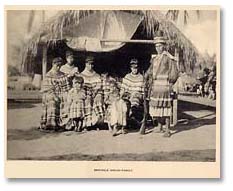 A Seminole Indian Family A Seminole Indian Family
South Florida has been shaped throughout its history by the unique blend of
people and cultures that have settled on its shores and in its swamps. In
the 1700s, Creek Indians from Georgia and Alabama joined with escaped
African-American slaves from the Southern states to form the Seminoles. In
efforts to preserve their land in middle Florida against the encroachments from
Southern slave owners after Spain ceded Florida to the United States in 1819, a
series of wars took place between the tribe and the federal government.
During the Second Seminole War (1835-1842), the longest and most
costly Indian war in American history, and then the third (1855-1858), Seminoles
who refused to be relocated west of the Mississippi penetrated the heart of the
Everglades to escape, and established communities there. They engaged in
small-scale agricultural production and crafts, and set up trading posts to sell
their goods to the white settlers who began migrating to Florida from the North
following the Civil War.
After the federal government passed legislation allowing Native
tribes to establish their political independence, the Seminoles drafted a
constitution and created a charter. Some members of the tribe who spoke the
Mikosuki language split from the Seminole to form the Miccosukee tribe. Both
tribes, officially recognized in 1957, continue their legacy in South Florida,
in activities ranging from tourism and gaming to citrus production and cattle
ranching.
|
|



